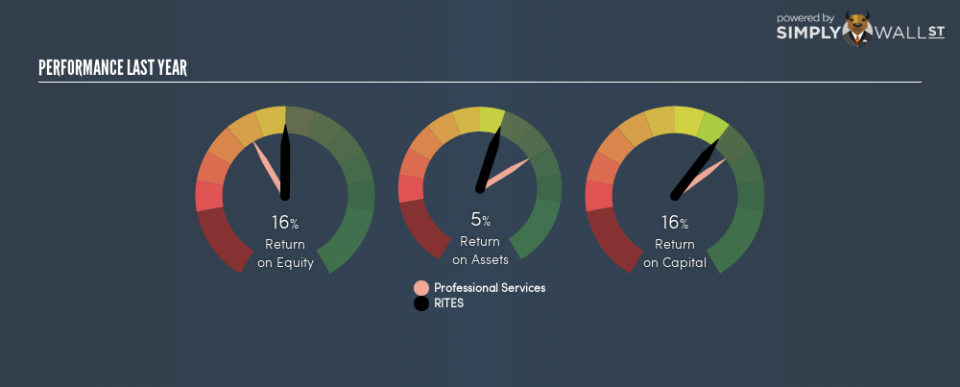Why You Should Like RITES Limited’s (NSE:RITES) ROCE

Today we are going to look at RITES Limited (NSE:RITES) to see whether it might be an attractive investment prospect. Specifically, we’re going to calculate its Return On Capital Employed (ROCE), in the hopes of getting some insight into the business.
First, we’ll go over how we calculate ROCE. Second, we’ll look at its ROCE compared to similar companies. And finally, we’ll look at how its current liabilities are impacting its ROCE.
Return On Capital Employed (ROCE): What is it?
ROCE measures the ‘return’ (pre-tax profit) a company generates from capital employed in its business. In general, businesses with a higher ROCE are usually better quality. Overall, it is a valuable metric that has its flaws. Renowned investment researcher Michael Mauboussin has suggested that a high ROCE can indicate that ‘one dollar invested in the company generates value of more than one dollar’.
So, How Do We Calculate ROCE?
The formula for calculating the return on capital employed is:
Return on Capital Employed = Earnings Before Interest and Tax (EBIT) ÷ (Total Assets – Current Liabilities)
Or for RITES:
0.16 = ₹4.2b ÷ (₹52b – ₹26b) (Based on the trailing twelve months to March 2018.)
So, RITES has an ROCE of 16%.
View our latest analysis for RITES
Want to help shape the future of investing tools and platforms? Take the survey and be part of one of the most advanced studies of stock market investors to date.
Does RITES Have A Good ROCE?
ROCE can be useful when making comparisons, such as between similar companies. In our analysis, RITES’s ROCE is meaningfully higher than the 10% average in the Professional Services industry. We would consider this a positive, as it suggests it is using capital more effectively than other similar companies. Regardless of where RITES sits next to its industry, its ROCE in absolute terms appears satisfactory, and this company could be worth a closer look.
When considering ROCE, bear in mind that it reflects the past and does not necessarily predict the future. Companies in cyclical industries can be difficult to understand using ROCE, as returns typically look high during boom times, and low during busts. ROCE is only a point-in-time measure. You can check if RITES has cyclical profits by looking at this free graph of past earnings, revenue and cash flow.
How RITES’s Current Liabilities Impact Its ROCE
Current liabilities include invoices, such as supplier payments, short-term debt, or a tax bill, that need to be paid within 12 months. Due to the way the ROCE equation works, having large bills due in the near term can make it look as though a company has less capital employed, and thus a higher ROCE than usual. To check the impact of this, we calculate if a company has high current liabilities relative to its total assets.
RITES has total liabilities of ₹26b and total assets of ₹52b. As a result, its current liabilities are equal to approximately 51% of its total assets. RITES’s current liabilities are fairly high, which increases its ROCE significantly.
Our Take On RITES’s ROCE
While its ROCE looks decent, it wouldn’t look so good if it reduced current liabilities. But note: RITES may not be the best stock to buy. So take a peek at this free list of interesting companies with strong recent earnings growth (and a P/E ratio below 20).
For those who like to find winning investments this free list of growing companies with recent insider purchasing, could be just the ticket.
To help readers see past the short term volatility of the financial market, we aim to bring you a long-term focused research analysis purely driven by fundamental data. Note that our analysis does not factor in the latest price-sensitive company announcements.
The author is an independent contributor and at the time of publication had no position in the stocks mentioned. For errors that warrant correction please contact the editor at editorial-team@simplywallst.com.

